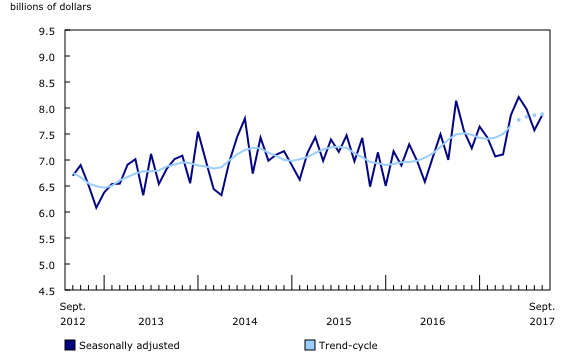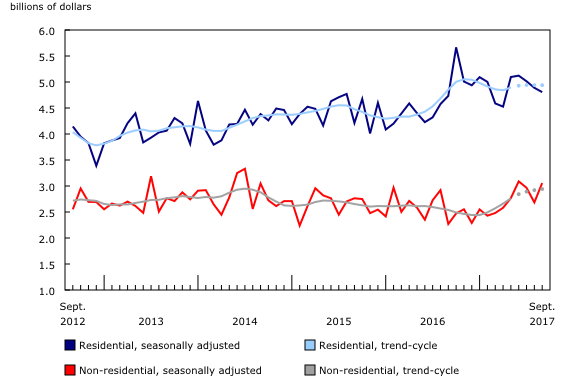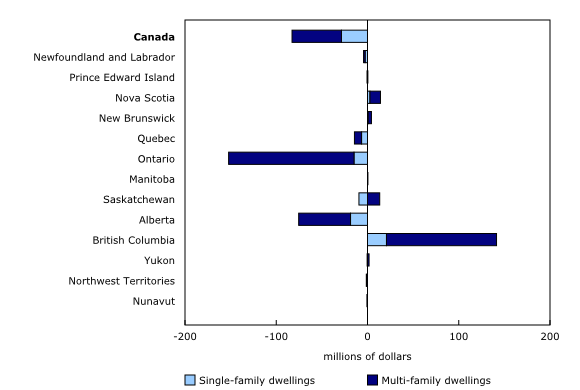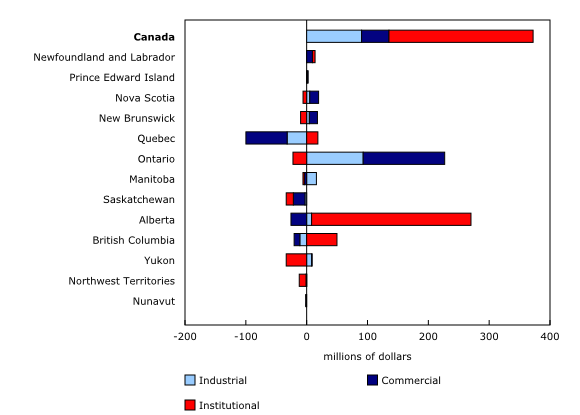Building permits, September 2017
Archived Content
Information identified as archived is provided for reference, research or recordkeeping purposes. It is not subject to the Government of Canada Web Standards and has not been altered or updated since it was archived. Please "contact us" to request a format other than those available.
Released: 2017-11-08
$7.9 billion
September 2017
3.8% 
(monthly change)
$84.8 million
September 2017
12.6% 
(monthly change)
$22.3 million
September 2017
10.1% 
(monthly change)
$144.8 million
September 2017
23.8% 
(monthly change)
$92.3 million
September 2017
15.0% 
(monthly change)
$1,386.7 million
September 2017
-6.5% 
(monthly change)
$3,006.3 million
September 2017
1.8% 
(monthly change)
$206.3 million
September 2017
5.3% 
(monthly change)
$152.8 million
September 2017
-16.3% 
(monthly change)
$1,321.7 million
September 2017
14.7% 
(monthly change)
$1,424.0 million
September 2017
13.6% 
(monthly change)
$17.1 million
September 2017
-57.6% 
(monthly change)
$2.4 million
September 2017
-84.7% 
(monthly change)
$0.0 million
September 2017
-100.0% 
(monthly change)
Value of institutional permits push up in September
Building permits rose in September for the first time in three months, as strength in the non-residential sector outweighed some weakness in the residential sector.
Canadian municipalities issued $7.9 billion worth of building permits in September, up 3.8% from the previous month. A 1.7% decrease in the residential sector was more than offset by a 13.9% increase in the non-residential sector. A high-value institutional building permit issued in Alberta was behind much of the increase.
The institutional component refers to buildings used to house public and semi-public services such as those related to health and welfare, education, or public administration, as well as buildings used for religious services. In September, a permit for a hospital was the main contributor to the 30.0% increase in the value of institutional building permits.
The value of residential building permits edged down $82.7 million (-1.7%) to $4.8 billion in September, the third consecutive monthly decline. Ontario posted the largest decrease, mainly due to lower construction intentions for apartments.
In British Columbia, the total value of residential permits increased 15.6% to $1.0 billion, marking the third month this year that the provincial value has hit the $1.0-billion mark. Construction intentions for apartment buildings in the census metropolitan area (CMA) of Vancouver drove the increase.
Municipalities issue record level of building permits in the third quarter
Municipalities issued $23.4 billion in building permits in the third quarter, up 1.0% from the previous quarter. However, this advance was slightly below the average quarter-to-quarter growth of 1.6% since the start of 2016.
The value of institutional building permits reached $2.7 billion in the quarter, with a significant portion coming from high-value permits for hospital buildings in Alberta and Ontario.
The multi-family component totalled $7.2 billion this quarter, up 1.7% from the last quarter and the third time in four quarters that the value has exceed $7.0 billion. British Columbia, Quebec and Nova Scotia all posted record highs for the multi-family component in the quarter. At the CMA level, multi-family permits in Montréal passed the $1.0 billion-mark for the first time on record, while the CMA of Halifax accounted for over 60% of the total value of multi-family dwelling permits in the Atlantic provinces.
Nationally, the commercial component decreased 3.3% to $4.3 billion in the third quarter. However, in the province of Quebec, the value of the commercial component rose to $943.7 million, the highest value since the second quarter of 2011. This increase contributed to the province's overall rise of 7.1%, to a record high of $4.4 billion.
For single-family dwellings, results were split between the east and west. In the third quarter of 2017, the value of single-family dwelling permits increased throughout the Atlantic provinces and Quebec. On the other hand, Ontario, the Prairie provinces and British Columbia all reported declines in the value of single-family dwellings.
The Building Permits Survey provides a snapshot in time
The monthly Building Permits Survey collects data on the value of permits issued by Canadian municipalities for residential and non-residential buildings. In addition to the value of the construction, the number of residential dwelling units authorized by the permits is also collected.
If there is a major construction project in a given community, the estimated value for the entire project may not necessarily be reflected in the data for one particular month. Construction does not necessarily start on the same month when the permit is issued and several permits are sometimes submitted for a given project. For example, a project may have a permit for the foundation issued one month and a separate permit issued for the building's shell in another. Furthermore, certain permits (e.g., excavation) are out of scope for this survey.
Building permit data provide a snapshot in time. The data are compiled at the time the permit is issued and, since the building permit is one of the first steps in the construction process, it can be considered a leading indicator for the construction industry.

In celebration of the country's 150th birthday, Statistics Canada is presenting snapshots from our rich statistical history.
When picturing the life of a factory or plant worker, one may think about Charlie Chaplin's depiction of factory life in the movie Modern Times. In 1936, when the silent film first came out, factory life and the seemingly endless assembly lines could easily be considered part of modern times. Since then, factories have become a key economic driver and technological advances have revolutionized how they operate.
In Canada, building permits for factories and plants peaked in 1989, with a total value of $3.6 billion. At that time, industrial projects in Ontario and Quebec fuelled the increase, with Ontario permits making up over 50% of the national total and Quebec accounting for just under 30%.
Given its size, Ontario has been the leader when it comes to the value of permits for factories and plants. For the past three decades, it has generally accounted for 40% to 55% of the national total. A recent exception came in 2012, when the value of permits issued in the province accounted for 28% of the national figure. That year, British Columbia, which normally accounts for less than 10% of the total, issued a record high of $654 million in permits. Significant industrial permits in the province caused the annual value to jump to over 20% of the national total.
Note to readers
Unless otherwise stated, this release presents seasonally adjusted data, which facilitate comparisons by removing the effects of seasonal variations. For information on seasonal adjustment, see Seasonally adjusted data – Frequently asked questions. The data presented in the Canada 150 section are not seasonally adjusted.
The Building Permits Survey covers over 2,400 municipalities, representing 95% of the Canadian population. The communities representing the other 5% of the population are very small and their levels of building activity have little impact on the total for the entire population.
Building permits data are used as a leading indicator of activity in the construction industry.
The value of planned construction activities presented in this release excludes engineering projects (such as waterworks, sewers or culverts) and land.
For the purposes of this release, the census metropolitan area of Ottawa–Gatineau (Ontario/Quebec) is divided into two areas: the Gatineau part and the Ottawa part.
Unless otherwise specified, the highlights refer to seasonally adjusted current dollars and are ranked in terms of dollar change rather than percentage change.
Revision
Data for the current reference month are subject to revision based on late responses. Data for the previous month have been revised.
Trend-cycle estimates have been added to the charts as a complement to the seasonally adjusted series. Both the seasonally adjusted and the trend-cycle estimates are subject to revision as additional observations become available. These revisions could be large and even lead to a reversal of movement, especially at the end of the series. The higher variability associated with the trend-cycle estimates is indicated with a dotted line on the chart.
For information on trend-cycle data, see the StatCan Blog and Trend-cycle estimates – Frequently asked questions.
Next release
Data for October on building permits will be released on December 7.
Products
The September issue of Building Permits (64-001-X) will soon be available.
Contact information
For more information, or to enquire about the concepts, methods or data quality of this release, contact us (toll-free 1-800-263-1136; 514-283-8300; STATCAN.infostats-infostats.STATCAN@canada.ca) or Media Relations (613-951-4636; STATCAN.mediahotline-ligneinfomedias.STATCAN@canada.ca).
- Date modified:





